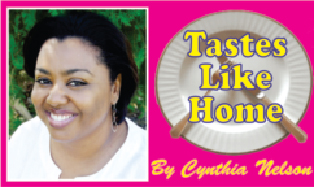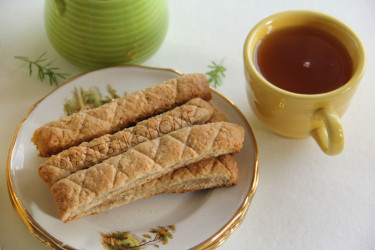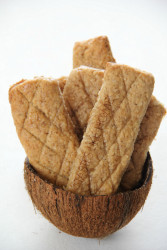Hi Everyone, There is something indescribable about the combination of freshly grated coconuts, flour, sugar, a little butter, ground cinnamon, grated nutmeg and a few drops of essence, all brought together by milk or water. Batter or dough, once baked, it satisfies not only the taste buds, but also a part of you where your heart always smiles, and feelings of comfort abound.
Whether it’s coconut buns, old fashioned coconut drops, sweet bread or lead pipes, the flavour notes are the same, however it is the shape, size and texture that differentiates one of these amazing baked coconut treats from the other. I grew up eating my mom’s coconut buns that she baked every Saturday afternoon. Still warm, we’d have them with homemade mauby or tea. When I moved to Barbados I fell in love with the coconut bread and was introduced to lead pipes, which are related to coconut/sweet bread.

Lead pipes are made from the old time recipe for coconut/sweet bread that consists primarily of freshly grated coconut, flour, sugar, a bit of essence and water. Back then, when available, I think that a bit of lard might have been added to the mixture. These sweet coconut treats are called lead pipes because of their shape and their texture. The dough once kneaded is rolled and cut into slender 6-inch pieces and when baked and cooled they become hard. So the hardness when biting into one seems like lead and when baked they resemble pipes from their shape, hence lead pipes. I’ll say this again, ‘you can’t beat we Caribbean people when it comes to naming things!’ We tell it like it is.
I had my first lead pipe in 1999. I was working at the then Caribbean Broadcasting Union, and my friend Stephen Rowe introduced me to it. Stephen not only offered me a lead pipe but also a couple slices of sharp cheddar cheese to eat with the lead pipe. I took the first bite and was put off by the hardness but once I took a bite of the cheese and chewed the two things together, my frown turned into a smile and Stephen laughed out loud. Since that first time, I have only had lead pipe on one other occasion – except for a couple of weeks ago when I made it myself. I am more a coconut sweetbread person.

(Photo by Cynthia Nelson)
There is a group on Facebook called Caribbean Recipes, and Caribbean people in and outside of the region are constantly posting images of food – particularly of what they have made. It is not really about written recipes only the “food porn” side of things to make us all hungry and sometimes jealous. Well, a Bajan guy living in New York posted a photograph of a sheet pan of baked lead pipes (his lead pipes had in raisins and cherries); all of us familiar with lead pipes went crazy. The man even got a marriage proposal then! We asked for the recipe but all he would say is that it is the same recipe for sweet bread. I knew there and then that it most definitely could not be the recipe I use for sweet bread because there is no way one could get that hard dough with baking powder and eggs in the mix. I made a few well-placed calls but none of them yielded any results. Most people complained that the lead pipes made these days were soft therefore they were not lead pipes.

My last call was to a family friend, Auntie Elsie, and after a lengthy discussion about life and lead pipes I felt emboldened to try my recipe sans baking powder and eggs. Based on a taste memory, I replaced the vanilla essence with almond essence. The only guide I had to go on was that the mixture has to be formed into a dough that could be kneaded. And so I set about making the lead pipes.
My coconut/sweet bread recipe calls for 3½ cups of flour but I found that I needed to add an additional ½ cup of flour as I kneaded the dough because the sugar naturally released moisture during the kneading process. The lead pipes turned out great in taste, flavour and texture, yes, they were hard but I think that I rolled the dough too thin so when it baked it spread a little more than I would have liked. I shared them with a couple of people outside of the regular tasting group, people who would know about lead pipes. Just as I thought, the flavour and texture were right but they too commented that they were a little too broad for traditional-looking lead pipes.
I debated with myself whether to go ahead and write this column using the images I had captured from that first batch but the perfectionist in me (I just rolled my eyes) insisted that I make lead pipes again so that they look like proper lead pipes (on my gosh, I just rolled my eyes again!).
This time I felt brave about sharing the lead pipes with a wider group. The response was heartening. My friend Patricia said, “It looks like lead pipe and it tastes like the old fashioned lead pipe. This reminds of the lead pipes I ate when growing up.”
Cynthia
Lead Pipes
Yield: 30 pieces
SPECIAL EQUIPMENT
1 (13” x 18” sheet pan), lined with parchment paper
Rolling pin
Pastry brush
INGREDIENTS
For glaze:
- 2 tablespoons brown sugar
- 2 tablespoons water
For lead pipes:
- 4 cups all-purpose flour, plus extra for work surface
- 1 teaspoon ground cinnamon
- ¼ teaspoon freshly grated nutmeg
- 4 oz. cold, unsalted butter
- 1 ½ cups brown sugar
- 2 cups freshly grated coconut
- 1 ¼ teaspoons almond essence
- ¾ cup whole milk or water (see note below)
DIRECTIONS
For glaze:
Mix together the sugar and water and set aside.
For lead pipes:
- Preheat oven to 350 degrees F.
- Add 3 ½ cups flour along with the cinnamon and nutmeg to a large bowl and mix well.
- Cut the butter into cubes and rub it into the flour.
- Add the sugar and coconut to the flour mixture and toss well to mix. Pour in the essence and milk and bring the mixture together to form a dough, it will be a little pasty. Gradually add in the remaining flour and knead in the bowl for 10 minutes.
- Transfer the dough to a floured work surface, flour a rolling pin and roll the dough into a 12” x 12” square.
- Using a sharp knife or dough scraper, cut the dough in half (it’s square so it does not matter if you cut long way or across). Now cut each half into 15 pieces, each piece should be about ¾-inch broad. You should have a total of 30 x 6-inch pieces of dough.
- Assemble on lined baking sheet; you can place them close together so they all fit or spread them apart. Score the dough by making crisscross cuts.
- Brush with sugar water and bake for 20 minutes. At the end of the 20 minutes, remove the pan from the oven, brush again with sugar water and return pan to oven and bake for another 20 – 25 minutes or until the lead pipes are hard to the touch.
- Remove from oven, rest in pan for 5 minutes and then transfer to wire rack to cool completely. Will keep at room temperature for 4 – 5 days stored in an airtight container.
NOTE
- You may need to add more milk/water if the mixture is too crumbly.





